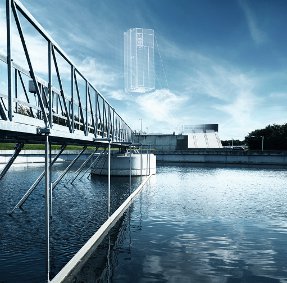The Shanghai Tower is on the most Top 5 lists that rank energy-efficient buildings. Buildings are the largest contributors to climate change through their carbon emissions, but they are becoming greener as technology and tenant behaviors lower the impact of urbanization on the planet. The media company Eco-Business has ranked the Top 5 most energy-efficient buildings - among them is Shanghai Tower. Danfoss has supplied its "Heating" and "Drives" products to the 632-meter-high building. Photo: Xinhua News Agency/eyevine/Danfoss.
Putting Energy Efficiency First
In a world challenged by a growing population, booming urbanization, and the clear issues surrounding climate change, energy-efficient solutions – doing more with less – are a ready-to-use answer.
Our future rests on a force invisible to the naked eye. It is there when Mr. Kuzmich turns up the heat in his Moscow apartment on a chilly January morning, and when Ms. Rossi in São Paolo pushes up the office air conditioning a few notches as the sun comes blazing in. It is there in Shanghai, where Mr. and Mrs. Wang are going about their daily business, together with 14 million fellow Shanghainese.
The force is energy, of course – if we use it efficiently, there will be enough for everybody in this generation, and many more to come. The technologies that can ensure the sustainable use and development of our energy resources are already in place and ready to be used.
Today, there are more than 7 billion global citizens – just one generation from now, there will be an additional 2 billion mouths to feed. Regrettably, one-third of the food produced today is lost or goes to waste. At the same time, the food sector accounts for one-third of the world’s energy consumption. So, by addressing food waste and energy waste, the food sector can literally help feed the world, and the solutions to accomplish this are already available.
Danfoss technologies can help unlock the huge potential to make better use of food supplies while saving energy at the same time. For example, our hydraulic motors make farm machines more efficient and optimize a farm’s harvest to bring more food to the table. Our refrigeration control systems save one-fifth of the energy consumed in food production while minimizing food waste. This supports Sustainable Development Goal 12, which calls for cutting global per capita food waste in half by 2030.
Energy efficiency to avoid climate change
Using energy efficiently not only helps us accomplish more with less, it also does our climate a favor. According to estimates provided by the International Energy Agency (IEA), energy efficiency can deliver as much as 38 percent of the emission reductions needed by 2050 to keep the planet within the 2 degrees Celsius limit necessary to address global warming.
Political action is needed to achieve this: The IEA figures also indicate that only one-third of the global energy-efficiency potential can be reached through current policies. However, with the right policies in place, Danfoss has the technologies to help deliver on this potential, thereby supporting Sustainable Development Goal 7, which calls for ensuring access to affordable, reliable, sustainable, and modern energy for all.
Urban efficiency is key
Energy efficiency also plays a key role in our cities. Urban neighborhoods are about to boom across the world. Today, half of us live in cities, but by 2050, two-thirds of the world’s population will have settled in these metropolises, even though more than half of the urban areas that will house this population have not yet been built.
This means that visionary mayors and city developers across the world have the opportunity to get it right from the beginning by establishing new city areas and upgrading systems in old neighborhoods. A lot can be achieved, for example, by looking at supermarkets as the backbones of smart cities.
Danfoss technologies can connect supermarkets to electricity and heating networks, enabling better use of both. For example, at a local supermarket near Danfoss headquarters in Denmark, excess heat from the refrigeration system is used for hot water and space heating within the store. The addition of a district heating connection also allows the supermarket to sell surplus heat to the local district heating company, thereby supplying heat to 16 homes every year. This “win-win” solution utilizes existing energy that would otherwise have been wasted, and incorporates district heating as a two-way energy infrastructure.

Addressing the cities of the future
With cities accounting for more than 80 percent of our economic output and 70 percent of the energy consumed around the world, the benefits of creating energyefficient cities are numerous.
Danfoss has been working together with ambitious cities and mayors for many years to create more livable cities. A great example is the 632-meter-high Shanghai Tower in China, which is one of the world’s greenest buildings and on most Top 5 lists that rank energy-efficient buildings. Due to growing Chinese urbanization, special demands are being placed on construction projects to reduce energy consumption and pollution.
The Danfoss control valves in Shanghai Tower automatically ensure the precise control and balancing of the water flow in the pipe work. This also means that people on the top floor quickly get the temperature they want, regardless of the temperatures preferred on the lower floors. Energy efficiency in the airconditioning system is further boosted by pressure transmitters and filter driers from Danfoss. More than 50 percent of the building’s energy consumption is due to the heating, ventilation, and airconditioning system, and 20 percent of this can be saved by using Danfoss control valves. For the heating and cooling systems, Danfoss variable-speed drives ensure that the pumps, compressors, and fans never run faster than is necessary to deliver the right temperature. This contributes to additional savings of 20–40 percent when compared to running these components without this technology.
Any city can copy this by improving both new and existing buildings; introducing district energy networks; cleaning water and producing energy at the same time; increasing the uptake of energy efficiency in the industrial sector; and by investing in efficient food infrastructure to feed the growing population. However, we need more scale, more speed, and more acceleration.
To accelerate urban efficiency, Danfoss works with allied stakeholders such as Sustainable Energy for All. As a partner in the District Energy in Cities Initiative from the United Nations Environment Programme, Danfoss has established a team of district energy experts to support cities in developing, retrofitting, or scaling-up district energy systems. The team will assist more than 30 cities chosen in an extensive consultation process to identify municipalities with high district heating or cooling potential.
Danfoss engineers technologies that enable the world of tomorrow to do more with less. We meet the growing need for infrastructure, food supply, energy efficiency, and climate-friendly solutions.
About Danfoss
Danfoss
is one of the largest industrial companies in Denmark. The global group
is a leader within research, development and production, sales and
service of mechanical and electronic components for several industries.
Danfoss
has a large ownership share in one of the world’s leading manufacturers
and suppliers of mobile hydraulics, Sauer-Danfoss. Danfoss seeks to
obtain its goals with a minimal consumption of raw materials and energy,
the least possible impact on its surroundings and the most efficient
use of resources. Danfoss has a long tradition for a social
responsibility towards both employees and the surrounding environment.
Product Categories
- Refrigeration and A/C
- Heating
- VLT® Drives
- Solar Energy
- Industrial Automation
- High-Pressure Pumps
Source: danfoss.com
About Us // Privacy Policy // Copyright Information // Legal Disclaimer // Contact
Copyright © 2012-2018 macondo publishing GmbH. All rights reserved.
The CSR Academy is an independent learning platform of the macondo publishing group.









